Working principle of EDFA
The basic model of EDFA is shown in the figure below, which is mainly composed of erbium-doped fiber, pump source, isolator, combiner coupler, detector, and control circuit.
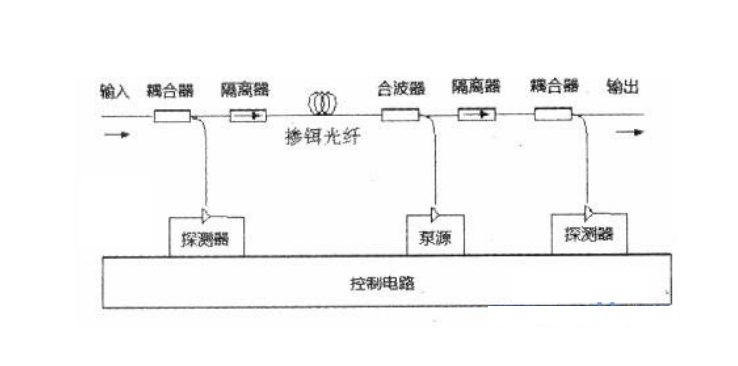
Among them, the primary and key device of EDFA; the function of pump source is to provide energy for EDFA, to excite the erbium ion in the baseband to high energy state, which causes the particle number to reverse, thus producing stimulated radiation, to realize the optical signal amplification of 1550nm band. The most widely used pump source is the 980nm LD isolator, which is mainly used to prevent the amplifier from self-excited vibration. The function of the wave combiner is to couple the pump light into the erbium-doped light. The coupler divides the signal light into a part and provides a detector to realize the real-time monitoring of the amplifier's working state.
The amplification principle of EDFA is similar to that of laser production. The energy difference between the metastable state and the ground state of Er (3 +) doped in the light is equal to the energy of 1550nm photon. When the pump energy (980nm or 1480nm) of the appropriate wavelength is absorbed, the electron will transition from the ground state to the excited state with higher energy order. Then a small amount of energy is released and transferred to a more stable metastable state. When the pump source is enough, the electron of Er ion will undergo a huge reversal. That is to say, the number of baseband electrons with high energy order is more than that with low energy order. When the appropriate light signal passes through, the metastable electrons will produce a stimulated radiation effect, emitting many photons of the same wavelength. Because of the existence of vibration energy order, the wavelength is not a single 21 range. The typical value is from 1530nm to 1570nm.
2、Gain of optical amplifier:
Gain G is a parameter describing the ability of an optical amplifier to amplify the signal. It is defined as:

Factors affecting the gain:
1. Pump power
2. The length of the baited fiber and the concentration of Er3 +
3. Input power, etc
Small gain and saturated output power
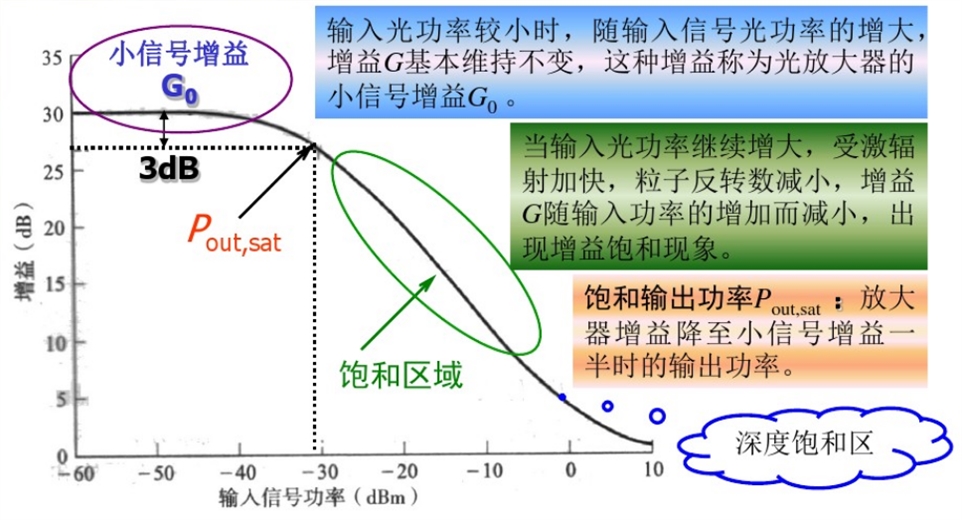
The relationship between gain and input optical power
In the process of signal amplification, various kinds of noises are inevitably superimposed, which leads to the deterioration of the signal-to-noise ratio. The parameter to measure the characteristics of EDFA noise is noise coefficient NF:

The relation curves of gain, noise index, output optical power and input optical power are as follows:
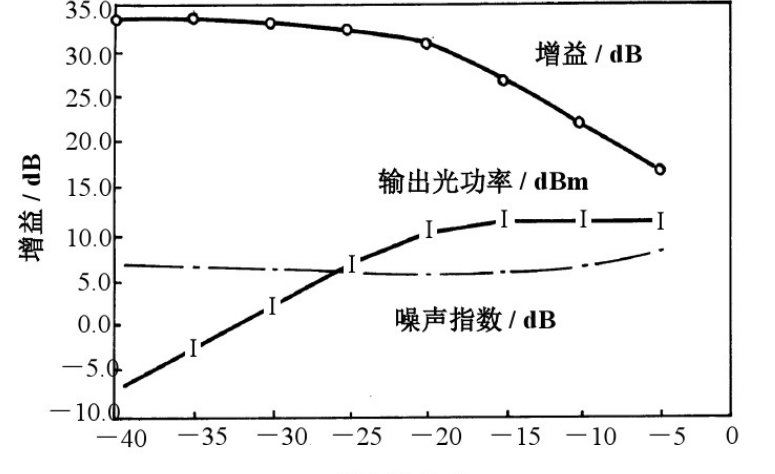
输入光功率d/Bm
Gain bandwidth: the range of signal wavelength with the signal gain within 3dB of the maximum gain decrease
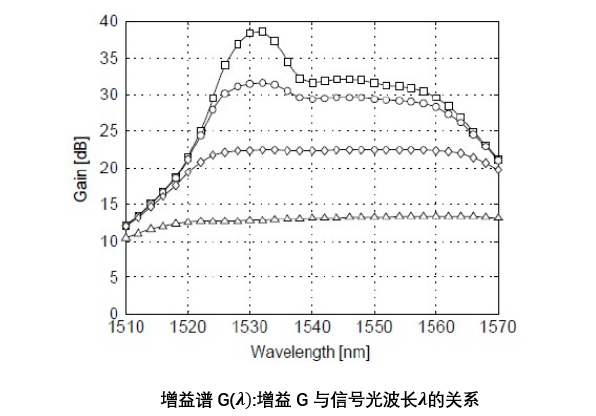
For a given EDF length, the gain increases exponentially with the pump power at the beginning. When the pump power exceeds a specific value, the profit rises slowly and tends to a constant value.

The relationship between small signal gain and pump power
When the pump power is fixed, the amplifier gains the maximum gain at a certain optimal length. If the amplifier length exceeds this value, the EDF after the optimal point can not be pumped enough because of the pump consumption. The amplified signal energy must be absorbed, resulting in the gain decrease quickly.
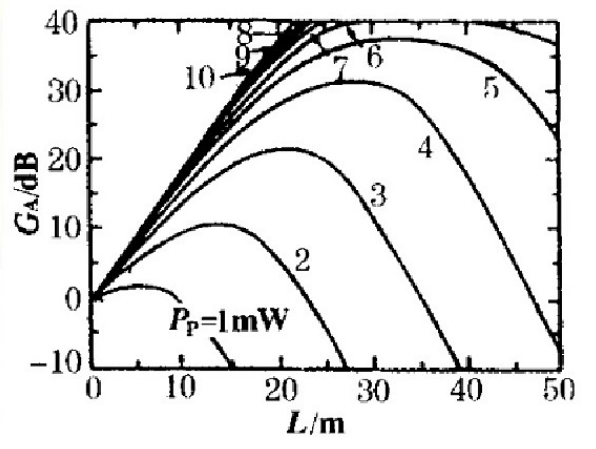
Relationship between small signal gain and EDF length
Therefore, in the EDFA design, it is necessary to select the appropriate pump power and fiber length based on the structure parameters of the erbium-doped fiber, which is the best condition for the amplifier to work.
3、Key technologies in EDFA:
1. EDFA gain flattening Technology
2. EDFA dynamic gain control and equalization technology
3. EDFA ultra wide band amplification technology
3.1 gain flattening Technology:3.1 gain flattening Technology:
Filter type: in EDFA, the internal difference passive filter can reduce the gain peak of 1530nm, or specially design the optical filter whose transmission is opposite to the gain spectrum of EDF to flatten the gain spectrum.
Intrinsic type: new wideband doped fiber is used, such as erbium-doped chloride fiber or erbium/aluminum phosphorus-doped fiber with high aluminum content. The advantage is that there is no need to make and introduce additional components. But the process is complex.
Intrinsic type: new wide band doped fiber is used, such as erbium-doped chloride fiber or erbium / aluminum phosphorus doped fiber with high aluminum content. The advantage is that there is no need to make and introduce additional components. But the process is complex.
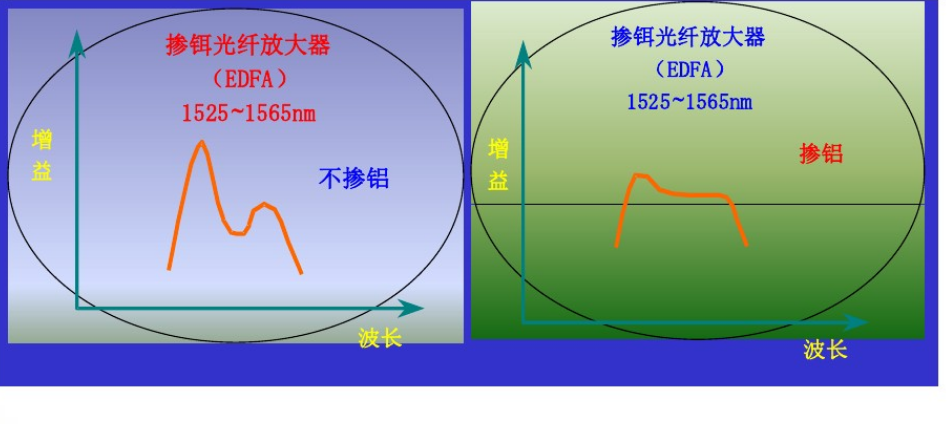
3.2 Gain locking technology of EDFA
WDM + EDFA is one of the primary means to realize high-speed, large capacity, and long-distance optical fiber communication.
In the multi-point to multi-point WDM transmission system, the up and downloading signals are usually needed, which may cause the transient fluctuation of each channel's optical power at any time. The solution is to introduce automatic gain and equalization into EDFA.
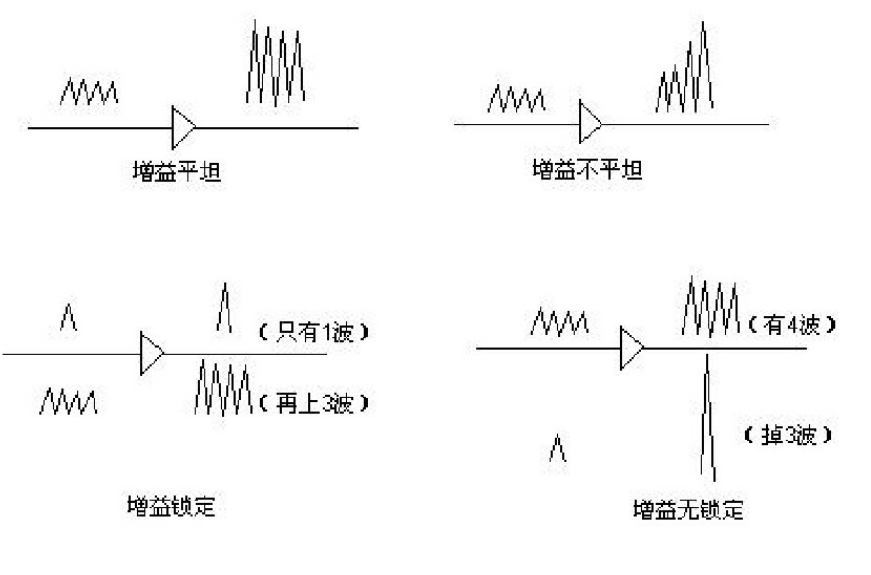
3.3 EDFA ultra wide band amplification technology
C band → C + L band
Cascade or parallel: C-band cascade or parallel L-band EDFA to achieve broadband gain. (ASE secondary pump, 1550nm auxiliary pump)
Intrinsic type: bismuth doped fiber is used instead of silicon-based erbium-doped fiber. C + L band broadband amplification can be realized.
Advantages of conquer EDFA
The working band just falls in the best window of optical fiber communication, and the coupling loss with transmission optical fiber is small. Up to 0.1db
high gain (30-40db), saturated output optical power up to 23dB
low noise index (4-7db)
frequency bandwidth (1525nm ~ 1565nm) can be used for multi-channel transmission, which is conducive to improving the transmission capacity.
The gain is independent of the polarization state of the signal and has good stability.
|
参数 |
单位 |
最小值 |
典型值 |
最大值 |
|
|
工作波长范围 |
nm |
1525 |
1565 |
||
|
输入信号功率范围 |
dBm |
-10 |
|||
|
小信号增益 |
dB |
30 |
35 |
||
|
饱和光功率输出范围* |
dBm |
17/20/23 |
|||
|
噪声指数** |
dB |
5.0 |
5.5 |
||
|
输入光隔离度 |
dB |
30 |
|||
|
输出光隔离度 |
dB |
30 |
|||
|
偏振相关增益 |
dB |
0.3 |
0.5 |
||
|
偏振模式色散 |
ps |
0.3 |
|||
|
输入泵浦泄漏 |
dBm |
-30 |
|||
|
输出泵浦泄露 |
dBm |
-40 |
|||
|
工作电压 |
模块 |
V |
4.75 |
5 |
5.25 |
|
台式 |
V( AC ) |
80 |
240 |
||
|
光纤类型 |
SMF-28 |
||||
|
输出接口 |
FC/APC |
||||
|
封装尺寸 |
模块 |
mm |
90×70×18 |
||
|
台式 |
mm |
320×220×90 |
|||
*The optical power depends on the customer's requirements
**The noise index test condition is that the gain is greater than 25dB





















